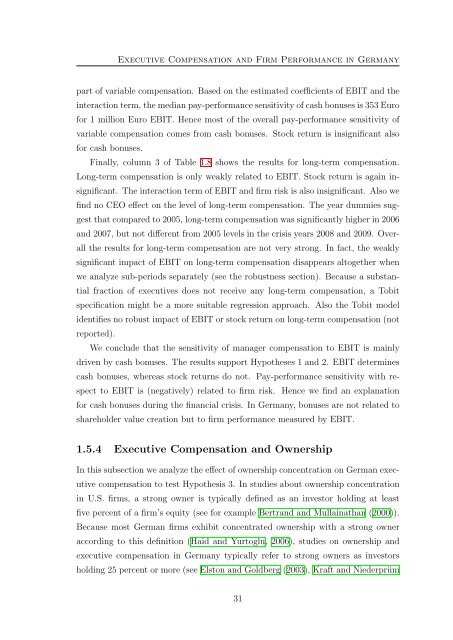Three Essays on Executive Compensation - KOPS - Universität ...
Three Essays on Executive Compensation - KOPS - Universität ...
Three Essays on Executive Compensation - KOPS - Universität ...
Create successful ePaper yourself
Turn your PDF publications into a flip-book with our unique Google optimized e-Paper software.
<strong>Executive</strong> Compensati<strong>on</strong> and Firm Performance in Germany<br />
part of variable compensati<strong>on</strong>. Based <strong>on</strong> the estimated coefficients of EBIT and the<br />
interacti<strong>on</strong> term, the median pay-performance sensitivity of cash b<strong>on</strong>uses is 353 Euro<br />
for 1 milli<strong>on</strong> Euro EBIT. Hence most of the overall pay-performance sensitivity of<br />
variable compensati<strong>on</strong> comes from cash b<strong>on</strong>uses. Stock return is insignificant also<br />
for cash b<strong>on</strong>uses.<br />
Finally, column 3 of Table 1.8 shows the results for l<strong>on</strong>g-term compensati<strong>on</strong>.<br />
L<strong>on</strong>g-term compensati<strong>on</strong> is <strong>on</strong>ly weakly related to EBIT. Stock return is again insignificant.<br />
The interacti<strong>on</strong> term of EBIT and firm risk is also insignificant. Also we<br />
find no CEO effect <strong>on</strong> the level of l<strong>on</strong>g-term compensati<strong>on</strong>. The year dummies suggest<br />
that compared to 2005, l<strong>on</strong>g-term compensati<strong>on</strong> was significantly higher in 2006<br />
and 2007, but not different from 2005 levels in the crisis years 2008 and 2009. Overall<br />
the results for l<strong>on</strong>g-term compensati<strong>on</strong> are not very str<strong>on</strong>g. In fact, the weakly<br />
significant impact of EBIT <strong>on</strong> l<strong>on</strong>g-term compensati<strong>on</strong> disappears altogether when<br />
we analyze sub-periods separately (see the robustness secti<strong>on</strong>). Because a substantial<br />
fracti<strong>on</strong> of executives does not receive any l<strong>on</strong>g-term compensati<strong>on</strong>, a Tobit<br />
specificati<strong>on</strong> might be a more suitable regressi<strong>on</strong> approach. Also the Tobit model<br />
identifies no robust impact of EBIT or stock return <strong>on</strong> l<strong>on</strong>g-term compensati<strong>on</strong> (not<br />
reported).<br />
We c<strong>on</strong>clude that the sensitivity of manager compensati<strong>on</strong> to EBIT is mainly<br />
driven by cash b<strong>on</strong>uses. The results support Hypotheses 1 and 2. EBIT determines<br />
cash b<strong>on</strong>uses, whereas stock returns do not. Pay-performance sensitivity with respect<br />
to EBIT is (negatively) related to firm risk. Hence we find an explanati<strong>on</strong><br />
for cash b<strong>on</strong>uses during the financial crisis. In Germany, b<strong>on</strong>uses are not related to<br />
shareholder value creati<strong>on</strong> but to firm performance measured by EBIT.<br />
1.5.4 <strong>Executive</strong> Compensati<strong>on</strong> and Ownership<br />
In this subsecti<strong>on</strong> we analyze the effect of ownership c<strong>on</strong>centrati<strong>on</strong> <strong>on</strong> German executive<br />
compensati<strong>on</strong> to test Hypothesis 3. In studies about ownership c<strong>on</strong>centrati<strong>on</strong><br />
in U.S. firms, a str<strong>on</strong>g owner is typically defined as an investor holding at least<br />
five percent of a firm’s equity (see for example Bertrand and Mullainathan (2000)).<br />
Because most German firms exhibit c<strong>on</strong>centrated ownership with a str<strong>on</strong>g owner<br />
according to this definiti<strong>on</strong> (Haid and Yurtoglu, 2006), studies <strong>on</strong> ownership and<br />
executive compensati<strong>on</strong> in Germany typically refer to str<strong>on</strong>g owners as investors<br />
holding 25 percent or more (see Elst<strong>on</strong> and Goldberg (2003), Kraft and Niederprüm<br />
31
















